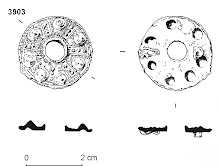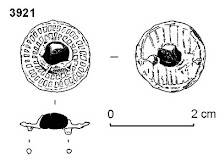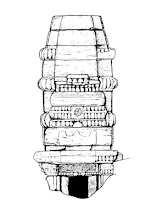A short break from 100 Minories post-excavation allowed a day trip to St Lawrence church, Sandhurst, Gloucestershire
to record their lead Romanesque font. The font is one of six surviving lead fonts
which were all cast from the same mould in the mid twelfth century, and all are
to be found in Gloucestershire. They were discussed by George Zarnecki in his
1957 book 'English Romanesque Lead Sculpture', but they have never been fully
illustrated or described.
 |
| Romanesque font at St Lawrence Church, Sandhurst, Gloucestershire (click to enlarge) |
The fonts are beautifully cast, with seated figures and
foliate interlace designs set within richly decorated arcades. The design
recalls on the one hand the figurative style of the Anglo-Saxon Winchester
School, mixed with Romanesque architecture, and details which are seen in
manuscript art c1130-1140, their probable date. Whilst recording the Sandhurst
font it was wonderful to meet a parishioner who had been baptised in the font
(it is still in use), over 800 years after it was first used.
The original mould block was of an arcade of four arches,
with alternating foliate interlace and figures enclosed within each arcade, and strips of palmette decoration along the top
and bottom of the arcade. Lead panels were cast from the mould, and several panels would
then be soldered together to create the font sides. The mould was shaped with a
curved top and bottom so the flat castings could be 'bossed' into the curved
tub shape without distortion; the base was then soldered on.
 |
| Interlace foliate designs alternate between seated figures, their hands raised in blessing (click to enlarge) |
The Sandhurst font has an arcade of eleven arches, the Lancault
font (in Gloucester Cathedral Lady Chapel) has ten, and the others twelve. The
soldered seams were hidden by being cast along the centre of the arcade colonnettes
(columns) and on some fonts an attempt has been made to hand carve decoration on
these soldered seams to echo that on the fully cast columns.
Although the same mould or former was used for all six
fonts, the castings are all slightly different, and each also bears the marks of their
long history. The Sandhurst font has very good detail of the right hand
raised in blessing -complete with crucifixion nail, yet other details are less
clear than in other castings. The faces of three of the five seated figures
were partially disfigured on the Sandhurst font-perhaps during the Reformation
or The Protectorate?
 |
| Defaced face of one of the seated figures on the Sandhurst lead font; the facial features have been selectively damaged. This may have been done during one of the periodic bouts of English iconoclasm, perhaps the Reformation, or during The Protectorate after the Civil War. |
There are also two graffiti on the Sandhurst font - one
incised next to the face of a figure, possibly SP or SR, and ?FWI below the
bottom palmette strip. Both graffiti are almost certainly of far later date than
the original casting.
I've
been working on the project to record the fonts for some time, but fieldwork meant
the project stalled whilst we dug the 100 Minories site in the City of London. Now I am back home in Gloucestershire the project is back on track and moving into the
next stage. Over a year ago I produced a detailed draft drawing of the font design, and over the next few weeks I will be re-visiting each of the six fonts, and using this
drawing to make further drawings and notes of each casting in order to produce
a detailed 'master drawing' of the intended
design. All the casting flaws, post-casting damage and repairs are also being
recorded as they form part of the 'biography' of each font. Once the drawings and notes are done, the castings can be compared and a definitive description written.
 |
| Drawing of the casting of the Lancault lead font, c1130-1140. The individual features of the six lead fonts will be combined to create a 'master drawing' of the intended design (click to enlarge) |
The fonts are located at Gloucester Cathedral Lady Chapel (font originally from Lancault), Tidenham, Siston, Sandhurst, Oxenhall, and Frampton-on-Severn.
 |
| Location of the six Romanesque lead fonts |
The final drawings and research will be published in due
course in an archaeological journal; and a 'layman's' version of the paper will
be donated to the six churches for their use.















